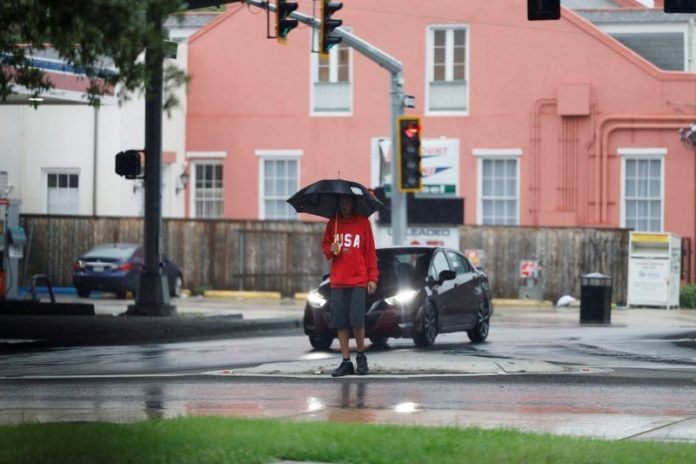By Ned Randolph
NEW ORLEANS (Reuters) -Hurricane Francine strengthened to a Category 2 storm on Wednesday just before it made landfall in Louisiana, threatening New Orleans and the wider Gulf Coast with powerful winds, rain and a storm surge that led to evacuation orders for thousands of people.
Francine packed maximum sustained winds of 100 miles per hour (155 kph) as the eye of the storm reached the southern Louisiana coast near Morgan City, Louisiana, about 90 miles (145 km) southwest of New Orleans, the U.S. National Hurricane Center said.
The hurricane center upgraded the storm from Category 1 previously on the five-step Saffir-Simpson scale. It classifies a Category 2 hurricane as producing extremely dangerous winds that will cause extensive damage. Little change in strength was expected before landfall later on Wednesday.
The storm was moving toward the northeast at 17 mph (28 kph), putting not just Morgan City but also New Orleans in the general path. The New Orleans metropolitan area was under a hurricane watch, meaning hurricane conditions were possible.
“It is on our doorstep. After the storm is over, please remain in place,” Louisiana Governor Jeff Landry told a press conference. “Stay off the roadway.”
Morgan City had already set a curfew until 6 a.m. on Thursday, Police Chief Chad Adams told journalists.
“We want everybody to just kind of shelter in place,” Adams said of the city’s 11,000 people.
After making landfall, the hurricane was expected to move across southeastern Louisiana on Wednesday night, the National Hurricane Center said.
Landry and U.S. President Joe Biden each declared a state of emergency in anticipation of the storm, freeing up emergency management resources and potential financial aid in the event of serious damage.
Several parishes, or counties, on or near the Louisiana Gulf Coast earlier issued mandatory evacuation orders, and the state transportation department issued evacuation maps. The city of New Orleans distributed sandbags at five sites.
Bourbon Street in New Orleans’ famed French Quarter was eerily empty on Wednesday afternoon as people heeded warnings to shelter in place. New Orleans had not experienced the expected winds or gusts as the eastern wall of the hurricane started to come onshore near Morgan City.
Any major storm near Louisiana evokes memories of Hurricane Katrina, the 2005 storm that devastated New Orleans and surrounding areas, killing nearly 1,400 people and causing $125 billion in damage, according to a 2023 hurricane center report.
Water from Lake Pontchartrain, which borders the city to the north, was starting to churn over its seawall. However since Katrina, the federal government built a $14.5 billion levee protection system, which includes storm water gates that can prevent storm surge into the city’s interior drainage canals, which experienced catastrophic failure during Hurricane Katrina.
Grocery stores were boarded up by late afternoon but not before veterans of previous storms loaded up on provisions.
“We’re all set. We have our canned goods. Have our supplies,” said Steve Rodriguez, who has lived in New Orleans since 1983 and was attempting some additional last-minute shopping. “I was hoping to get some sausage. I’ve got meat in the freezer but it would be easier to cook up some beans or something.”
The storm already had the effect of disrupting energy production and agricultural exports out of the U.S. Gulf of Mexico.
Nearly 39% of oil and almost half of natural gas production in the U.S. Gulf of Mexico was offline on Wednesday, according to the offshore regulator. A total of 171 production platforms and three rigs had been evacuated.
In Dulac, a coastal fishing community 70 miles southwest of New Orleans, fisherman Barry Rogers said he planned to ride out the storm on his 80-foot(24-meter)-long shrimp boat rather than his home.
“The house is not going no where. If it does, there’s nothing you can do about it,” he said. “If a rope breaks on the boat, I’d rather be there to tie up another one.”
(Reporting by Ned Randolph in New Orleans; additional reporting by Rich McKay in Atlanta and Brendan O’Brien in Chicago; Editing by Christian Schmollinger, Chizu Nomiyama, Jonathan Oatis, Marguerita Choy and Sandra Maler)
Disclaimer: This report is auto generated from the Reuters news service. ThePrint holds no responsibilty for its content.






